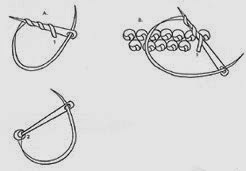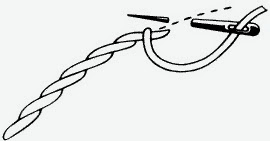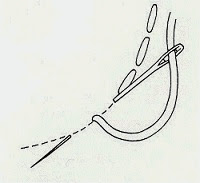Wednesday, April 30, 2014
Monday, April 28, 2014
Antique Chinese Embroidered Purses
Embroidered purses were important accessories during the Qing Dynasty (1644-1911). Purses were needed to carry daily necessities as there were no pockets in the gowns or jackets until the beginning of the twentieth century. But more than that, as a mark of social standing, the type and design of the purse would immediately alert bystanders to the status of the owner. They were given as gifts and to mark special occasions. Certain shops specialised in their manufacture, as with various other trades, there was even a street in Beijing devoted to their sale.
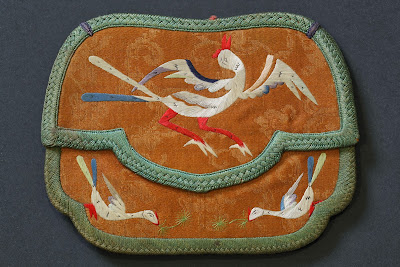 Purse 1
Purse 1
Size: 14cm x 11cm
Antique Chinese pouch purse comprised of apricot silk embroidered and finished with a light green border. This Chinese lady's purse was made with silk satin fabric and hand embroidered with silk thread using a satin embroidery stitch. The edges are bound with carefully aligned silk threads. Each side opens to a separate storage compartment and there is a third compartment which is accessed from the top of the purse. Made and used during the late Qing Dynasty, the quality of the materials and workmanship clearly show that this purse was used by a woman of means.
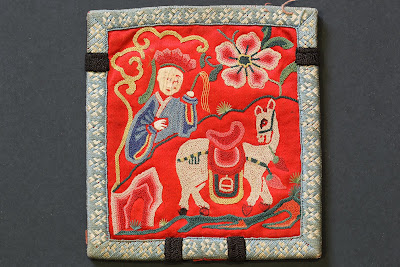 Purse 2
Purse 2
Size: 13cm x 11.5cm
Antique Chinese pouch purse comprised of red silk embroidered and finished with a light blue border. This Chinese lady's purse was made with silk satin fabric and hand embroidered with silk thread using a satin embroidery stitch. The edges are bound with carefully aligned silk threads. The storage compartment is accessed from the top of the purse. Made and used during the late Qing Dynasty, the quality of the materials and workmanship clearly show that this purse was used by a woman of means. Unfortunately, this use has left some wear patterns and some areas appear faded which would be expected in an embroidered piece of this age.
Size: 14cm x 11cm
Antique Chinese pouch purse comprised of apricot silk embroidered and finished with a light green border. This Chinese lady's purse was made with silk satin fabric and hand embroidered with silk thread using a satin embroidery stitch. The edges are bound with carefully aligned silk threads. Each side opens to a separate storage compartment and there is a third compartment which is accessed from the top of the purse. Made and used during the late Qing Dynasty, the quality of the materials and workmanship clearly show that this purse was used by a woman of means.
Size: 13cm x 11.5cm
Antique Chinese pouch purse comprised of red silk embroidered and finished with a light blue border. This Chinese lady's purse was made with silk satin fabric and hand embroidered with silk thread using a satin embroidery stitch. The edges are bound with carefully aligned silk threads. The storage compartment is accessed from the top of the purse. Made and used during the late Qing Dynasty, the quality of the materials and workmanship clearly show that this purse was used by a woman of means. Unfortunately, this use has left some wear patterns and some areas appear faded which would be expected in an embroidered piece of this age.
Sunday, April 27, 2014
Chinese Embroidery Techniques
Embroidery is a traditional Chinese craft which consists of pulling colored thread through a background material with needle to stitch patterns that have been previously designed. Silk embroidery are paintings with needle and silk thread. They are subject of great beauty and historical importance, providing an important cultural link with the past. Because silk embroidery is also involved with very much complicated handcrafted work, they do have great monetary and emotional value.
Below are the list of some common used embroidery stitches.
1. Seed stitch
Seed stitch, is also known as knot stitch, Chinese knot, Peking knot, French knot, ring embroidery or forbidden stitch. These terms all consistently refer to small knots made on the fabric surface by wrapping a heavy embroidery thread, usually silk floss, around a needle and then stitching it down. This has been done with varying numbers of wrappings and degrees of complexity. More than twenty varieties of knot stitch can be found throughout history, presumably in East Asia alone. Early relics of this stitch have been found in an Eastern Han tomb at Nuoyinwula, Outer Mongolia, and even earlier examples on a pair of silk shoes discovered in a tomb of the Warring States period in Linzi, Shandong Province.
"Forbidden stitch" in Chinese embroideries normally refers to the "seed" or "knotted" stitches used along with satin stitches and couching on highly decorative, finely-worked silk costume items. One romantic view suggests that this label appeared when such work was forbidden among young girls because its fineness contributed to eyestrain. A close look at Chinese embroidery, however, discloses a variety of other stitches that are sometimes worked with similar intricacy.
2. Pekinese stitch
Pekinese stitch, is also known as the Peking stitch or Chinese stitch. The embroidery structure is quite different from the Knot stitches. On embroideries where the work is especially fine, however, it's not always to easy to recognize the difference without severe magnification.
First, a back stitch is laid down, with stitches that are fairly long and loose. Then, with a blunt needle, the Pekinese stitch itself is laced through the back-stitch segments, going forward two and back through one to form a series of loops. The finished appearance can differ depending upon the kinds of threads or floss used, the size of the stitches, and how firmly the thread is pulled. Among Chinese embroideries, the Pekinese stitch has been used more often for linear elements, rather than as fillings for large areas.
3. Couching stitch
Couching is a technique for attaching a length of thread to a base fabric by taking tiny stitches over it at regular intervals. The word couch comes from the French verb "coucher" which means to lay down, so it really applies to attaching just about anything as long as it uses stitches over or on top.
4. Long and short stitch
Long and short stitch is very similar to the free overlap stitch. The difference is that the lines in the free overlap stitch lie flat. The stitch marks of the free overlap stitch are hidden between the lines, while those in the long-and-short stitch are visible.
The long and short stitch is used mostly for embroidering flowers, plants tree trunks and rocks. In the first layer, long and short lines are arranged with a neat edge. In the second layer, stitches of the same length are inserted in the spaces of the first layer, stitches of the third layer are inserted in the spaces of the second layer. The remaining layers are embroidered according to this pattern. Because the lines are connected layer by layer, the embroidered face is flat and thin, and the stitches are visible. The composition of the lines is more flexible and color gradations aren’t as rigid.
5. Stem stitch
Stem stitch is used to connect each stitch with the previous one. The stitching line is relatively bold and the individual stitches are short. The work started by making the first stitch (1mm) at one end of the design. The second stitch is made into the first stitch hole so that each stitch is connected with the last, forming a small bead-like stitch. With the luster of the silk threads, these stitches look like crystal beads and are especially decorative.
6. Chain stitch
Chain stitch is a sewing and embroidery technique in which a series of looped stitches form a chain-like pattern. Chain stitch is an ancient craft, examples of surviving Chinese chain stitch embroidery worked in silk thread have been dated to the Warring States period (5th – 3rd century BC). Handmade chain stitch embroidery does not require that the needle pass through more than one layer of fabric. For this reason the stitch is an effective surface embellishment near seams on finished fabric. Because chain stitches can form flowing and curved lines, they are used in many surface embroidery styles that mimic "drawing" in thread.
7. Random stitch
The art of random stitch embroidery featured the "closely needled in parallel lines", by adopting stitch replacing brush and ink, and using threads as colors, which perfectly combines the principles of Western paintings with Chinese embroidery and enables the artist to express her own feelings freely.
The complexity and rarity of the random stitch embroidery is just the random. However, the "random" is actual a kind of random with certain principle and rules, and "random" is used to serve a unification of the whole and a change for liveliness. The embroiderer may control the changes of stitch lines, long or short, thick or thin, loose or dense, light or dark color based on her own intention. Besides, the embroiderer may direct stitch by her "feeling", and present her thought by "lines", and utilize changeable stitch lines to present the beauty of line and 3D effect according to the change law of light and color. Therefore, the random we see from the embroidery works really makes sense and meets rules, and makes people feel the vitality spurted from the random, and the dynamics presented from the random.
Random stitch embroidery focuses on color effects, and it demands much more multi-plain processes than the normal embroidery. Therefore, the work of random stitch embroidery looks like a piece of oil painting, but differs from oil painting. Since luster shown on silk lines, and stitch lines with different directions on the embroidery surface present changeable colors under the light in different angles. However, two colors on the oil painting will become another color after mixed and combined, and the original two colors would become invisible. On the contrary, the threads with two colors on the embroidery surface may obtain. Therefore, the random stitch embroidery enjoys brighter and changeable colors than oil painting, and achieves a unique style.
8. Buttonhole stitch
Buttonhole stitches catch a loop of the thread on the surface of the fabric and needle is returned to the back of the fabric at a right angle to the original start of the thread. The finished stitch in some ways resembles a letter "L" depending on the spacing of the stitches. The properties of this stitch make it ideal for preventing raveling of woven fabric.
There are another two very basic techniques for the Chinese embroidery.
9. Basic or even stitch
10. Back stitch
To see the examples of the mentioned embroidery techniques, do check out my coming blogs of the Chinese textiles from my collection. :)
Below are the list of some common used embroidery stitches.
1. Seed stitch
Seed stitch, is also known as knot stitch, Chinese knot, Peking knot, French knot, ring embroidery or forbidden stitch. These terms all consistently refer to small knots made on the fabric surface by wrapping a heavy embroidery thread, usually silk floss, around a needle and then stitching it down. This has been done with varying numbers of wrappings and degrees of complexity. More than twenty varieties of knot stitch can be found throughout history, presumably in East Asia alone. Early relics of this stitch have been found in an Eastern Han tomb at Nuoyinwula, Outer Mongolia, and even earlier examples on a pair of silk shoes discovered in a tomb of the Warring States period in Linzi, Shandong Province.
"Forbidden stitch" in Chinese embroideries normally refers to the "seed" or "knotted" stitches used along with satin stitches and couching on highly decorative, finely-worked silk costume items. One romantic view suggests that this label appeared when such work was forbidden among young girls because its fineness contributed to eyestrain. A close look at Chinese embroidery, however, discloses a variety of other stitches that are sometimes worked with similar intricacy.
2. Pekinese stitch
Pekinese stitch, is also known as the Peking stitch or Chinese stitch. The embroidery structure is quite different from the Knot stitches. On embroideries where the work is especially fine, however, it's not always to easy to recognize the difference without severe magnification.
First, a back stitch is laid down, with stitches that are fairly long and loose. Then, with a blunt needle, the Pekinese stitch itself is laced through the back-stitch segments, going forward two and back through one to form a series of loops. The finished appearance can differ depending upon the kinds of threads or floss used, the size of the stitches, and how firmly the thread is pulled. Among Chinese embroideries, the Pekinese stitch has been used more often for linear elements, rather than as fillings for large areas.
3. Couching stitch
Couching is a technique for attaching a length of thread to a base fabric by taking tiny stitches over it at regular intervals. The word couch comes from the French verb "coucher" which means to lay down, so it really applies to attaching just about anything as long as it uses stitches over or on top.
4. Long and short stitch
Long and short stitch is very similar to the free overlap stitch. The difference is that the lines in the free overlap stitch lie flat. The stitch marks of the free overlap stitch are hidden between the lines, while those in the long-and-short stitch are visible.
The long and short stitch is used mostly for embroidering flowers, plants tree trunks and rocks. In the first layer, long and short lines are arranged with a neat edge. In the second layer, stitches of the same length are inserted in the spaces of the first layer, stitches of the third layer are inserted in the spaces of the second layer. The remaining layers are embroidered according to this pattern. Because the lines are connected layer by layer, the embroidered face is flat and thin, and the stitches are visible. The composition of the lines is more flexible and color gradations aren’t as rigid.
5. Stem stitch
Stem stitch is used to connect each stitch with the previous one. The stitching line is relatively bold and the individual stitches are short. The work started by making the first stitch (1mm) at one end of the design. The second stitch is made into the first stitch hole so that each stitch is connected with the last, forming a small bead-like stitch. With the luster of the silk threads, these stitches look like crystal beads and are especially decorative.
6. Chain stitch
Chain stitch is a sewing and embroidery technique in which a series of looped stitches form a chain-like pattern. Chain stitch is an ancient craft, examples of surviving Chinese chain stitch embroidery worked in silk thread have been dated to the Warring States period (5th – 3rd century BC). Handmade chain stitch embroidery does not require that the needle pass through more than one layer of fabric. For this reason the stitch is an effective surface embellishment near seams on finished fabric. Because chain stitches can form flowing and curved lines, they are used in many surface embroidery styles that mimic "drawing" in thread.
7. Random stitch
The art of random stitch embroidery featured the "closely needled in parallel lines", by adopting stitch replacing brush and ink, and using threads as colors, which perfectly combines the principles of Western paintings with Chinese embroidery and enables the artist to express her own feelings freely.
The complexity and rarity of the random stitch embroidery is just the random. However, the "random" is actual a kind of random with certain principle and rules, and "random" is used to serve a unification of the whole and a change for liveliness. The embroiderer may control the changes of stitch lines, long or short, thick or thin, loose or dense, light or dark color based on her own intention. Besides, the embroiderer may direct stitch by her "feeling", and present her thought by "lines", and utilize changeable stitch lines to present the beauty of line and 3D effect according to the change law of light and color. Therefore, the random we see from the embroidery works really makes sense and meets rules, and makes people feel the vitality spurted from the random, and the dynamics presented from the random.
Random stitch embroidery focuses on color effects, and it demands much more multi-plain processes than the normal embroidery. Therefore, the work of random stitch embroidery looks like a piece of oil painting, but differs from oil painting. Since luster shown on silk lines, and stitch lines with different directions on the embroidery surface present changeable colors under the light in different angles. However, two colors on the oil painting will become another color after mixed and combined, and the original two colors would become invisible. On the contrary, the threads with two colors on the embroidery surface may obtain. Therefore, the random stitch embroidery enjoys brighter and changeable colors than oil painting, and achieves a unique style.
8. Buttonhole stitch
Buttonhole stitches catch a loop of the thread on the surface of the fabric and needle is returned to the back of the fabric at a right angle to the original start of the thread. The finished stitch in some ways resembles a letter "L" depending on the spacing of the stitches. The properties of this stitch make it ideal for preventing raveling of woven fabric.
There are another two very basic techniques for the Chinese embroidery.
9. Basic or even stitch
10. Back stitch
To see the examples of the mentioned embroidery techniques, do check out my coming blogs of the Chinese textiles from my collection. :)
Subscribe to:
Comments (Atom)

